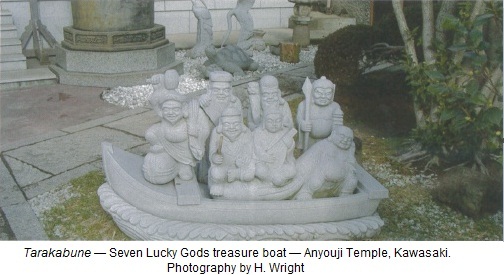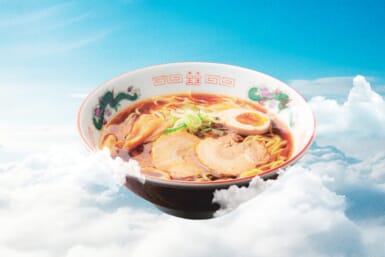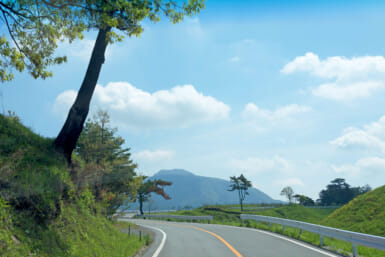Hillel Wright makes a pilgrimage to these lucky gods
In some ways, the Shichifukujin or Seven Lucky Gods are part of the same world as the maneki neko (beckoning cat), the daruma doll and the tanuki (raccoon dog) statuette. They are all physical representations of that most abstract quality… Luck. But in many other ways, the Shichifukujin, being deities, may be able to offer more powerful blessings than mere luck.
Who are the Seven Lucky Gods?
Ebisu, god of fishing, farming and business, is the only homegrown Japanese god of the group. Traditionally the fisherman’s god, he was eventually adopted by rice farmers and, more recently, businessmen. Ebisu is the one carrying the fishing pole and the large fish.
The following three gods, like much of Japanese culture, come from China. Fukurokuju, the god of happiness, is a bearded old man with the unmistakable ‘conehead’ and is often accompanied by a crane or tortoise. Juroujin, another bearded old man, the one with the flat top scholar’s cap and accompanied by a deer, is the god of long life, and the bald, big bellied Hotei, carrying a Santa Claus-like large treasure sack and a fan like that of a sumo referee, is the god of wisdom.
The last three gods originate from India. Benzaiten (Sarasvati in Sanskrit) is the lone goddess of the group and carries a biwa or Japanese lute and is the goddess of art. Daikokuten (Mahakala in Sanskrit) is a jolly short fat god. Standing on rice bales and carrying a mallet is the god of prosperity, and Bishamontcn (Vairasvani), wearing a helmet and carrying a spear, is the god of a better future.
Making your Pilgrimage
The order in which you make your pilgrimage is not set in stone. You can walk, bike, or even drive. Both JR and Tokyo Metro provide route maps at their stations around New Year so you can do the pilgrimage by train or subway. The pilgrimage doesn’t need to be done in a day, so many walk to the various shrines or temples over a period of several days.
An important ritual, besides saying a prayer at each location, is to carry a shousasshi (booklet) or shikishi (square formal certificate) and to have each priest stamp them with an official hanko or seal. The shikishi is usually framed and hung after the pilgrimage is completed. The charge for stamping the hanko is usually ¥200.
When to make your Pilgrimage
It’s not surprising that the most orthodox time to make the Seven Lucky Gods pilgrimage or shichfukujin meguri is the first seven days of the New Year. In practical terms this makes things easier, since the temples and shrines keep their box offices open and have plenty of shikishi and other lucky items for sale.
The Pilgrimage Locations
The spiritual aspect of the Seven Lucky Gods resides within the confines of Buddhist Temples (tera) or Shinto Shrines (jinja). There are many locations in which to pay your respects, so it is advisable to find the route most convenient for you. I first discovered my local pilgrimage trail on a map of Nakahara-ku obtained at my local ward office. You can also get maps at shrines and temples dedicated to one or another of the shichifukujin, and the internet is also useful.
Reasons to make your Pilgrimage
To some, the Seven Lucky Gods pilgrimage is superstition, while to others it is religion, or at least spirituality. My own take is somewhere in between. I believe that prayer is a kind of directed psycho-cybernetic energy and can, like other forms of psychic energy, have an effect on the physical world.
As a former commercial fisherman, I have a special affinity for Ebisu and every year I offer special prayers at the Ebisu Temple Dairaku-in for my son Hano, also a commercial fisherman on the West Coast of Vancouver Island.
Just before starting out on my meguri, I got a long distance phone call from him. He told me he had a good season financially with “a little excitement.” In typical seaman’s understatement, the excitement turned out to be the sinking of his boat in a rare West Coast hurricane in late October. Hurricanes are practically unheard of on the Pacific Coast of North America. But 2005 was notable for disastrous extremes in nature — hurricanes, floods and earthquakes of epic proportions.
The Canadian Fishing Vessel my son was on, ‘Westerly Gale,’ after being caught at sea in the hurricane, began taking in water faster than the pumps could handle and started to founder. The captain decided to abandon ship and sent out an S.O.S. In an act of heroism little short of miraculous, the ship was reached by a Canadian Coast Guard vessel and all three crewmen, my son Hano included, were rescued before their ship went down. For a fisherman to be rescued from a sinking ship in a hurricane surpasses any concept of Luck and can only be considered a blessing.
Needless to say, my prayers to the lucky god Ebisu this year included a substantial measure of gratitude.









